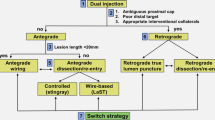Abstract
Here, we report a case of successful interventional revascularization of the left anterior descending artery (LAD) in two heavy calcified chronic total occlusion (CTO) lesions, which were uncrossable utilizing hybrid procedural steps of local rotational atherectomy and a retrograde approach by reverse controlled antegrade and retrograde tracking (CART) technique via an ipsilateral intraseptal collateral. A-76-year-old man that had undergone previous coronary artery bypass surgery was admitted for ischemic heart failure. Coronary angiography showed that the left internal thoracic artery graft that was anastomosed to the first diagonal branch was patent. However, his native LAD had two CTOs as if the open vessel had sandwiched them. Moreover, there were no interventional collaterals. The antegrade guidewire was successfully passed through both CTOs. However, devices were uncrossable at the entry of the distal LAD-CTO. After stent deployment at the proximal CTO, local rotational atherectomy with a 1.5 mm burr was performed as plaque modification from the protruding calcified plaque at the bifurcation of the first septal branch to the distal CTO entry for the following procedure, although the dedicated guidewire was unable to pass completely through the distal CTO segment. Staged PCI to the distal LAD-CTO was performed using a retrograde approach via an ipsilateral intraseptal collateral, which had grown due to recanalization of the proximal LAD-CTO. Due to plaque modification by rotablation at the first attempt, successful interventional revascularization to the distal LAD-CTO was accomplished using the reverse CART technique.





Similar content being viewed by others
References
Stone GW, Reifart NJ, Moussa I, et al. Percutaneous recanalization of chronically occluded coronary arteries: a consensus document: part II. Circulation. 2005;112(16):2530–7.
Pagnotta P, Brigouri C, Mango R, et al. Rotational atherectomy in resistant chronic total occlusions. Catheter Cardiovasc Interv. 2010;76(3):366–71.
Stone GW, Colombo A, Teirstein PS, et al. Percutaneous recanalization of occluded coronary arteries: procedural techniques, devices, and results. Catheter Cardiovasc Interv. 2005;66(2):217–36.
Brilakis ES, Banerjee S. Crossing the “balloon uncrossable” chronic total occlusion: tornus to the rescue. Catheter Cardiovasc Interv. 2011;78(3):363–5.
Hirokami M, Saito S, Muto H. Anchoring technique to improve guiding catheter support in coronary angioplasty of chronic total occlusions. Catheter Cardiovasc Interv. 2006;67(3):366–71.
Michael TT, Banerjee S, Brilakis ES. Subintimal distal anchor technique for “Balloon-uncrossable” chronic total occlusions. J Invasive Cardiol. 2013;25(10):552–4.
Tsuchikane E, Katoh O, Kimura M, et al. The first clinical experience with a novel catheter for collateral channel tracking in retrograde approach for chronic coronary total occlusions. J Am Coll Cardiol Cardiovasc Interv. 2010;3:165–71.
Azzalini L, LY HQ. Laser atherectomy for balloon failure in chronic total occlusion: when the going gets tough. Int Heart J. 2014;55:000–123.
Surmely JF, Tsuchikane E, Katoh O, et al. New concept for CTO recanalization using controlled antegrade and retrograde subintimal tracking; the CART technique. J of Invasive Cardiology. 2006;18:334–8.
Kitane AJ, Stone GW. The Anchor-Tornus technique: a novel approach to “uncrossable” chronic total occlusions. Catheter Cardiovasc Interv. 2007;70(4):554–7.
Kovacic JC, Sharma AB, Roy S, et al. GuideLiner mother-and-child guide catheter extension: a simple adjunctive tool in PCI for balloon uncrossable chronic total occlusions. J Interv Cardiol. 2013;26(4):343–50.
Ohya H, Katoh O. A Case of Successful Cracking of Calcified Fibrous Cap of Totally Occluded Left Anterior Descending Artery by Using Cutting Balloon. J Am Coll Cardiol. 2014;63(12):S135–6.
Pagnotta P, Briguori C, Ferrante G, et al. Tornus catheter and rotational atherectomy in resistant chronic total occlusions. Int J Cardiol. 2013;167(6):2653–6.
Levin DC. Pathways and functional significance of the coronary collateral circulation. Circulation. 1974;50:831–7.
Otsuji S, Terasoma K, Takiuchi S. Retrograde recanalization of a left anterior descending chronic total occlusion via an ipsilateral intraseptal collateral. J Invasive Cardiol. 2008;20(6):312–6.
Numasawa Y, Motoda H, Yamazaki H, Kuno T, Takahashi T. Successful percutaneous coronary intervention of a chronic totally occluded left anterior descending artery via an ipsilateral intraseptal channel using intravascular ultrasound-guided retrograde wire-crossing technique. Cardiovasc Interv Ther. 2014;29:157–61.
Acknowledgments
All procedures followed were in accordance with the ethical standards of the responsible committee on human experimentation (institutional and national) and with the Helsinki Declaration of 1964 and later revision.
Author information
Authors and Affiliations
Corresponding author
Ethics declarations
Conflict of interest
M Tanabe, A.Wada, and O. Doi declare that they have no conflict of interest.
Informed consent
Informed consent or substitute for it was obtained from the patient in the study.
Rights and permissions
About this article
Cite this article
Tanabe, M., Wada, A. & Doi, O. Successful interventional revascularization utilizing hybrid procedural steps of rotational atherectomy and retrograde approach via an ipsilateral collateral. Cardiovasc Interv and Ther 31, 309–315 (2016). https://doi.org/10.1007/s12928-015-0359-8
Received:
Accepted:
Published:
Issue Date:
DOI: https://doi.org/10.1007/s12928-015-0359-8




